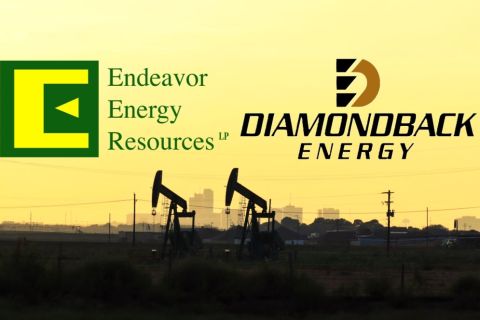
Vast oil shale reserves lie below the stately butte and mesa country between Colorado’s Rockies and Utah’s Wasatch Mountains.
Back in the day, crocodiles cruised through the swamps of subtropical Colorado. That day, the Eocene Era, lasted 22 million years and ended about 34 million years ago, but its legacy could sway energy-driven geopolitics for decades.
The kerogen-rich oil shales of the Green River Formation, which wind their way from the Piceance (PEEawnts) Basin in northwestern Colorado through the Uinta (You-IN-tuh) Basin in northeastern Utah to the Greater Green River Basin of southwestern Wyoming, are estimated by the U.S. Geological Survey (USGS) to hold nearly 4.3 trillion barrels (bbl) of oil. Of that, the USGS pegs the technically recoverable resource at between 353 billion bbl and 1.15 trillion bbl.
Put into perspective, the U.S. Energy Information Administration (EIA) estimates that global proved crude oil reserves totaled 1.646 trillion bbl at the end of 2013.
Adding the low estimate from the Piceance and Uinta basins bolsters the total by 21.4%. Adding the high estimate would expand global reserves by 69.6%, a portion large enough to supply the U.S. with oil for 165 years. Some 800 billion bbl are estimated to be economically recoverable, or about three times the proved reserves of Saudi Arabia.
Thick oil
To be clear, the stratospheric volumes refer to oil shale—not shale oil. The former contains kerogen, a precursor to crude oil, which is why it is identified as thermally immature. The latter is obtained from shale rock through hydraulic fracturing. To obtain crude oilfrom oil shale, the rock must be heated to the range of 530 F to 930 F. Heating expends energy, so is the development of oil shale economically and environmentally viable?
Apparently so.
“Testing is being carried out on U.S. oil shale by a variety of operators,” Steve Sonnenberg, professor and Boettcher chair of petroleum geology at the Colorado School of Mines, told Midstream Business. He cited South Jordan, Utah-based Red Leaf Resources Inc.’s Seep Ridge project in Utah; Rifle, Colo.-based American Shale Oil LLC’s testing in the Piceance Basin; and ExxonMobil Corp.’s work in the region.
The University of Utah’s Institute for Clean and Secure Energy explored the topic in its 2013 study for the U.S. Department of Energy’s National Energy Technology Laboratory, “A Market Assessment of Oil Shale and Oil Sands Development Scenarios in Utah’s Uinta Basin.” The study analyzed U.S. energy policy and public concerns over oil shale and oil sands development. It evaluated water resources, land use, air quality and carbon management, then delved into the economic viability of unconventional fuel development in four scenarios that begin in 2012 and end in 2035. The scenarios include: underground mining of shale, underground heating of shale, surface mining and processing of oil sands and steam assisted gravity drainage of oil sands.
Rate of return
Assuming that investors require a 10% minimum rate of return and that the EIA’s price forecast for industry-benchmark West Texas Intermediate crude (WTI) to 2035 is accurate, the study concluded that:
- A 50,000 bbl/d production facility for the underground mining and surface retorting of oil shale would be profitable; and
- A 10,000 bbl/d production facility for the surface mining and processing of oil sands would be profitable.
Assuming that investors are willing to accept a 9% rate of return, the study found that:
- A 10,000 bbl/d production facility for the steam-assisted gravity drainage of oil sands would be profitable as well.
However, the study concluded that:
- A 50,000 bbl/d production facility for the underground heating of oil shale would not be profitable, given the projected price of oil.
To extract oil shale via underground mining and surface retorting, two processes are considered. In extraction, retort refers to a process using an airtight vessel in which the rock is heated to enable a chemical reaction. In this process, raw shale oil is hydrotreated, resulting in a WTI-quality synthetic crude oil. The scenario has this oil sent by pipeline from the field in the northeast section of the Uinta Basin to refineries in North Salt Lake City, Utah.
The two surface retort methods used in this scenario are Paraho Direct, developed in the 1960s, and Tosco II. Paraho uses high temperatures which result in greater production of CO2 from carbonate decomposition; the CO2 is of pipeline quality and can be sold. The Tosco air-fired technology produces negligible amounts of CO2.
Capital investment for a Tosco II air-fired plant is $5.941 billion; cost of a Tosco II pure oxygen-fired plant is $6.192 billion. The Paraho Direct air-fired plant costs $4.789 billion, or almost 23% less than the more expensive Tosco II oxy-fired plant and 19% less than the air-fired plant.
The scenario for the profitable surface mining and processing oil sands plant is far less expensive. The site would be the Asphalt Ridge-Whiterocks Special Tar Sands Area, located southwest of Vernal, Utah. An air-fired plant in this scenario is priced at $818 million and an oxygen-fired plant at $848 million.
The steam-assisted gravity drainage process, also deemed profitable, is one that is commonly used in Alberta. Output of CO2 is estimated to be 60% higher than the surface mining option, but this process spares the area of a large waste stream of oil sand tailings that surface mining produces.
The price tag on a complete, steam-assisted gravity drainage process facility with air-fired upgrading plant is $1.3 billion. The oxygen-fired version raises that price to $1.328 billion.

Encana Corp. has extensive operations in the Williams Fork play of the Piceance Basin in Colorado. Source: Encana Corp.
Will it work?
Red Leaf Resources Inc. is testing the profitability theory on 1,600 acres of rich, near-surface oil shale in the Seep Ridge Formation near Vernal where it is heating hydrocarbon-rich solid organic material to produce crude oil, condensate and natural gas. Red Leaf, in partnership with Total E&P USA Inc., is deploying its EcoShale technology on a commercial demonstration project site. A decision on whether to expand operations into a 10,000 bbl/d commercial production facility will depend on the results.
“Red Leaf ’s patented EcoShale process was designed specifically to address environmental concerns surrounding traditional oil shale extraction methods,” Adolph Lechtenberger, CEO, told Midstream Business. “Our process requires less energy, uses less water and has a lighter environmental impact than any oil shale process anywhere in the world.”
EcoShale In-Capsule technology involves mining the kerogen-rich oil shale, placing it into a clay-lined capsule the size of a football field, covering the shale with layers of impermeable clay and soil and heating it with natural gas over a period of months to produce crude oil, natural gas and condensate.
The process uses no discharge water and the company intends it to be an economic and far more environmentally friendly way to produce transportation fuels. Red Leaf monitors both within and below the capsule and will share that data with state officials and environmental groups. A coalition of environmental groups has agreed to drop an appeal of its suit challenging Red Leaf ’s permit for its commercial demonstration project.
Well-trained
The economics of Uinta Basin shale oil are tied not to its superabundance but to its high paraffin content. The waxy oil must be heated to 100 F to enable it to flow through a pipeline—diluent such as condensate used to move Canadian tar sands heavy crude does not work with waxy crude—so other, more expensive options like trucks and rail are employed. This negatively impacts price.
At the close of the first week of September, Chevron’s Crude Oil Marketing unit posted a price of $75.29/bbl for Uinta Basin Black Wax crude oil (32° API), 18.7% below benchmark WTI on the New York Mercantile Exchange. The sharply discounted price might seem discouraging, but low costs can open up markets, like the big one on the West Coast. To get it there, crude is shipped by rail.
California refiners doubled the volume of their crude oil imports from Utah in June (2,737 bbl/d) over the previous month as shipments declined from both Canada (25%) and North Dakota (34%).
Garland Shaw, CFO of Houston-based Ultra Petroleum Inc. declared in an earnings call that “rail capacity is the best option to place our barrels. By 2016, we expect to market approximately 45% of our crude oil volumes via rail.” The company already has agreements to move 2,000 bbl/d from its assets in the Uinta, with possible expansions to as much as 7,500 bbl/d.
Liquids component
Production in the Uinta-Piceance Basin province dates to the White River Field in Colorado in 1890, where drilling was initiated near surface oil seeps. Another round of exploration began in the 1920s and resulted in Utah’s first gas discovery in Uinta County, the Ashley Valley Anticline, in 1925.
By the 1960s, seismic mapping had led to the realization that production was controlled in many structural traps. The strategy of exploring stratigraphic traps in both conventional and unconventional plays continues today.
In the Piceance, WPX Energy (formerly Williams Exploration & Production) operates 221,186 net acres and boasts a portfolio of 3.019 trillion cubic feet of proved gas reserves. Gas prices have remained stubbornly low with a near-term outlook of more of the same. Making money depends on liquids.
“WPX and other companies are now targeting the Niobrara, which is deeper than the traditional Mesaverde completions,” said Sonnenberg. “The right depth interval needs to be targeted to ensure that the company is drilling in the ‘oil window or liquids-rich window,’ however. Deeper drilling will encounter mainly gas. Liquids-rich gas plays are attractive to operators, but low gas prices have discouraged drilling for gas-only projects.”
“What we’re doing in the Piceance is a good gauge of how companies who have natural gas plays approach the business,” Alan Harrison, WPX’s vice president of drilling operations, said in an interview with the Colorado Oil & Gas Association.
“That is: If we can make money in the current commodity environment, taking into account the outlook for prices—which doesn’t show a tremendous amount of gain—then we’re going to try to sustain our production levels or grow them at a very moderate pace,” he added.
“What helps us make money on natural gas plays is the fact that we do have a liquids component via NGL recoveries, which helps us with our price,” Harrison said. “Our economics are strong because of the efficiencies we have incorporated into our operations, not only on the drilling and completions side, but with how we operate our wells. We’ve done quite a bit of analysis that shows in the Piceance our cost structure is probably one of the best. That, combined with our gas contracts and hedging, is why we can sustain a moderate level of activity even in a relatively low commodity price market with our short-term goal to sustain production levels, and then proceed to grow.”
Encana’s execution
Calgary-based Encana Corp. echoes the liquids attraction.
“Encana has excelled at execution and continuous improvement in the Williams Fork play of the Piceance Basin,” Doug Hock, media relations manager for Encana Services Co. Ltd., told Midstream Business. “We minimize environmental impacts, drive down development costs and optimize completions to improve well productivity and economic returns. Encana’s current strategy is to focus on our key liquids plays in our portfolio, but to maintain gas optionality, including the Piceance Basin. We operate over 3,000 wells in the play, but at the present time we aren’t actively drilling in the Piceance.”
After decades of hydrocarbon production, the aging infrastructure of the Piceance and Uinta basins could use an overhaul.
“Infrastructure will need to be continuously improved and will be very capitalintensive, keeping short-term economic returns in check,” said Hock. “It may control the pace of development.”
And it needs to grow.
“There is an existing infrastructure, but it probably will need to be enlarged if the oil shale projects kick off successfully,” Sonnenberg said. “The main challenges will be environmental and political.”
In Colorado, the debate over hydraulic fracturing has led to a battle between government entities. The Longmont, Colo., City Council voted to restrict where wells could be located and were met by two lawsuits from the state government. At the moment, though, the controversy is not in the basin’s neighborhood.
“Colorado has some unique political challenges related to push-back from local stakeholders,” said Hock. “However, this is primarily playing out on the more densely populated Front Range at this time. The Piceance Basin has unique challenges due to the terrain, federal leases and wildlife and environmental restrictions.”
Outlook
Occidental Petroleum CEO Steve Chazen has hinted that his company’s Piceance Basin presence, which it has maintained since the 1970s, may be near an end as it shifts its focus to the Permian Basin. Other parties are interested, though.
WPX Energy recently partnered with TRDC LLC, a subsidiary of Houston-based G2X Energy, to jointly develop its Trail Ridge properties, part of its Piceance operations. The deal represents 27 Bcf of proved developed reserves and 46 Bcf of proved undeveloped reserves. TRDC also has committed to a $170 million drilling carry on nearly 400 future wells and will make additional investments for its 49% working interest.
Earlier this year, Dallas-based Summit Midstream Partners LP purchased Red Rock Gathering Co. LLC from a subsidiary of Summit Midstream Partners LLC for total cash consideration of $305 million.
Red Rock is a gas gathering and processing system in the Piceance Basin with about 1,480 miles of low-pressure and high-pressure pipeline, 54,000 horsepower of compression and two processing plants with 50 MMcf/d of processing capacity. The Red Rock system gathers and processes natural gas, primarily under fee-based contracts, for more than 55 producer customers.
Natural gas on the Red Rock system interconnects with downstream pipelines serving Enterprise Products Partners LP’s Meeker Natural Gas Processing Plant, Williams Partners LP’s Northwest Pipeline system and Kinder Morgan’s TransColorado Pipeline system. Processed natural gas liquids from the Red Rock system are injected into Enterprise’s Mid-America Pipeline system.
The Colorado School of Mines Niobrara Consortium is studying the Niobrara Formation and finding that much of the new drilling is encountering success in the Piceance and Sandwash basins, Sonnenberg said. “Early results suggest large potential for these areas.”
Joseph Markman can be reached at jmarkman@hartenergy.com or 713-260-5208.
Recommended Reading
EIA: E&P Dealmaking Activity Soars to $234 Billion in ‘23
2024-03-19 - Oil and gas E&Ps spent a collective $234 billion on corporate M&A and asset acquisitions in 2023, the most in more than a decade, the U.S. Energy Information Administration reported.
Analysts: Diamondback-Endeavor Deal Creates New Permian Super Independent
2024-02-12 - The tie-up between Diamondback Energy and Endeavor Energy—two of the Permian’s top oil producers—is expected to create a new “super-independent” E&P with a market value north of $50 billion.
ConocoPhillips CEO Ryan Lance: Upstream M&A Wave ‘Not Done’ Yet
2024-03-19 - Dealmaking in the upstream oil and gas industry totaled $234 billion in 2023. The trend shows no signs of slowing, ConocoPhillips CEO Ryan Lance said at the CERAWeek by S&P Global conference.
Is Double Eagle IV the Most Coveted PE-backed Permian E&P Left?
2024-04-22 - Double Eagle IV is quietly adding leases and drilling new oil wells in core parts of the Midland Basin. After a historic run of corporate consolidation, is it the most attractive private equity-backed E&P still standing in the Permian Basin?
Marketed: EnCore Permian Holdings 17 Asset Packages
2024-03-05 - EnCore Permian Holdings LP has retained EnergyNet for the sale of 17 asset packages available on EnergyNet's platform.





